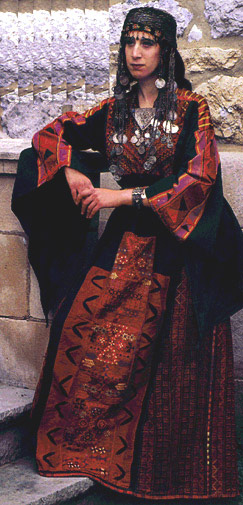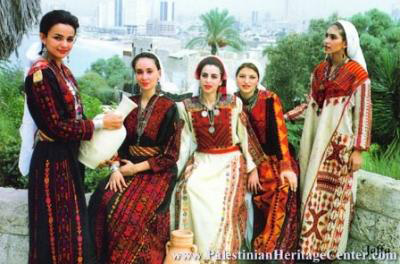 Palestinian traditional clothing culture is so rich and admirable, it has inspired for centuries the tailors and fashion designers not only in Palestine itself but far across its borders to create masterpieces using Palestinian authentic embroidery patterns, traditional silhouettes and shapes of garments, typical colors, and breathtaking jewelry pieces. Most people around the world know too little about the beauty of Palestinian clothing traditions. We’d like to correct this injustice at least partly, so this material will reveal a few curious secrets of the folk costume of Palestine and its influence on European medieval and 18th-19th century fashion.
Palestinian traditional clothing culture is so rich and admirable, it has inspired for centuries the tailors and fashion designers not only in Palestine itself but far across its borders to create masterpieces using Palestinian authentic embroidery patterns, traditional silhouettes and shapes of garments, typical colors, and breathtaking jewelry pieces. Most people around the world know too little about the beauty of Palestinian clothing traditions. We’d like to correct this injustice at least partly, so this material will reveal a few curious secrets of the folk costume of Palestine and its influence on European medieval and 18th-19th century fashion.
The photos were provided by the Embassy of Palestine in Ukraine
Palestinian folk gowns from the 19th century from different regions of the country have practically the same cut. That’s amazing because such a thing rarely happens with traditional clothing. Usually, every region has its own peculiarities, and the regional folk costumes can vary significantly, sometimes dramatically. In Palestine, traditional garments differ mostly in ornamentation and decoration, but the silhouette remains the same – a cute A-line dress, with one rectangular panel creating the front top part and another panel at the back, and with triangular-shaped sleeves that widen toward the palm.
This particular silhouette of a dress, with its geometrical shapes and easily-cut details, originally served to use the fabric smartly, because fabric was expensive, so every piece of it should have been used. That’s why we see rectangular and triangular (basically, a rectangular cut in half) pieces of cloth. Often, Palestinians bought embellished pieces of fabric, for instance, with a brocaded border. Of course, these pieces had a rectangular shape as well.

The dress is worn belted with a wide belt. And a lot of other accessories and pieces of clothing go with the main dress. As is common for most folk costumes around the world, Palestinian national attire is multilayered.
Another typical feature of Palestinian traditional clothes is embroidery – a lot of needlework at the front, back, sides, sleeves, and hem. But it wasn’t the only embellishment – Palestinians loved jewelry and often adorned their festive, especially bridal, gowns with coins sewn to the bodice. You can sometimes see vintage dresses that have a whole front and back of the bodice covered with such silver coins – the local women knew how to impress with their appearance.
Every Palestinian dress has a decorative chestpiece. By its design, patterns, and colors, specialists distinguish garments from different areas of Palestine. This chestpiece is adorned with intricate embroidery (lots of it), which is the centerpiece of a garment.

Except for the dress, Palestinian women wore very beautiful and ornate traditional headpieces. As usual with headgear, there were everyday, festive, bridal, and other styles of them, worn in accordance with the occasion. The most elaborate were the bridal headdresses, obviously. They were richly decorated, expensive, and spectacular – adorned with coins, jewels, embroidery, and other decorations.
Most headdresses consisted of some item similar to a skull-cap or headband (or two such caps) + a veil. The veil was rather large and, usually, embroidered, and the hat was diverse for different regions and eras. In general, the traditional Palestinian style of headwear derives from the pre-Roman times when women wore an ornate headdress or tiara or something similar around their head and on top, they put a large veil that covered the head, neck, shoulders, and even back (partially or fully).
In the 19th – early 20th century, townswomen wore both traditional-style dresses (rarer) and modern Ottoman or other garments (more often). But villagers still preferred traditional clothing. Each woman had 3-8 dresses in her possession. They didn’t need a lot of clothes and didn’t spend money on buying or making more than they needed. Besides, the cut was always the same, the difference was only in detail, so women would rather buy one ornate and costly dress than 5 simple and cheap garments. Of course, they had a few daily dresses and a few ensembles for a special occasion.

What we seldom talk about is the influence the Arab culture had on European fashion of various periods (from the medieval to the 18th and 19th centuries). Some historians even say that fashion trends traveled from Europe to the Middle East, when in reality, it was vice versa. We sometimes can see Arabic or pseudo-Arabic writing on the borders of medieval clothing in the paintings and etchings. Or some typically Middle Eastern patterns and ornamentation is used to decorate European ladies’ gowns in the 18th-19th century. This came from the Arab countries, like Palestine, Syria, Lebanon, etc. Simply because such decoration was beautiful and exotic.
All those silks and brocades, widely available in this part of the world, attracted European merchants. In most cases, ready-made garments or brocade fabrics were exported to the Western world, but sometimes, the fabrics with Arab ornamentation were even produced in Europe, the artisans imitated calligraphy, symbols, and patterns from the Middle East. And if to think logically, it’s totally understandable, as Europe was the center of world fashion for centuries, so a lot of overseas trends came and accumulated here, mixed together, and created gorgeous fashion trends. And Palestine was one of those countries, whose rich and splendid clothing culture inspired tailors and fashion designers not only in Palestine itself but far across its borders.


